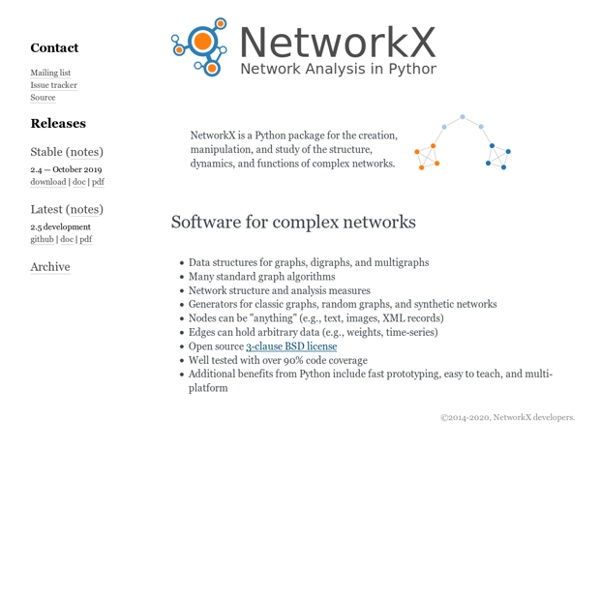



NodeXL: Network Overview, Discovery and Exploration for Excel - Home as Piël » Socket Benchmark of Asynchronous Servers in Python There has already been written a lot on the C10K problem and it is known that the only viable option to handle LOTS of concurrent connections is to handle them asynchronously. This also shows that for massively concurrent problems, such as lots of parallel comet connections, the GIL in Python is a non-issue as we handle the concurrent connections in a single thread. In this post i am going to look at a selection of asynchronous servers implemented in Python. Asynchronous Server Specs Since Python is really rich with (asynchronous) frameworks, I collected a few and looked at the following features: What License does the framework have? This gave me the following table. This is quite a list and i probably still missed a few. Orbited / Twisted (callbacks)Tornado (async)Dieselweb (generator)Eventlet (greenlet)Concurrence (stackless)Circuits (async)Gevent (greenlet)Cogen (generator) To quickly summarize this list; Twisted has been the de-facto standard to async programming with Python. Code Twisted
dse 4.0.0-RC1 DSE - Simplified "bulk" insert/update/delete for Django. Version : 4.0.0 - Release Candidate #2Author : Thomas Weholt <thomas@weholt.org>License : Modified BSD.Status : BetaUrl : DSE is available for one reason - to insert/update/delete lots of data -- as fast as possible.DSE vs Django ORM: typical speed gain is around 5x-10X for updates, 3X+ for inserts.DSE is aware of default values specified in your Django models and will use those if no value is given for a field in an insert statement.DSE caches SQL-statements, both inserts, updates and delete, and executes them when a specified number of statements has been prepared or when it`s told manually to flush cached statements to the database. The actual sql execution is done using DB API cursor.executemany and this is much faster than executing SQL-statements in sequence and way faster than using the Django ORM.DSE uses a dictionary to specify what fields to work on. You got a model like: Using dse: NB!
UCINET Software Customer Support For customer support (e.g., ordering info, billing etc) contact roberta@analytictech.com. For tech support join the users group or contact support@analytictech.com. We prefer you try the users group first since the answer to your question may benefit others. In addition, you should check out the support page, which includes useful things like tutorial exercises. Fixes, improvements, upgrades UCINET is constantly being upgraded to fix problems, provide new capabilities, or generally make things better. Download and/or Purchase The program can be downloaded and used for free for 90 days. Requirements and Specifications Windows operating system Vista or later. Coding styles comparison in the Open Source world While looking for existing C coding standards I discovered that the GNU and Linux projects officially suggest very different styles. Inside the Linux kernel documentation, Linus Torvalds goes so far as to mock GNU coding standards: First off, I’d suggest printing out a copy of the GNU coding standards, and NOT read it. Burn them, it’s a great symbolic gesture. At this point I wanted to understand the difference between the coding styles of established open source projects. Many stylistic aspects can’t be compared directly because they are different languages, but it was interesting to map some of them, for example indentation and maximum line length: About indentation, the styles describe differently the indentation of function declarations from the indentation of branches (thanks to TaQ for the Ruby suggestions and to JoeT for the correction on the Java example): Like this: Like Loading... Related Simplest bare metal program for ARM In "Embedded"
sanokore/UI-Input-Validator NetLogo Home Page NetLogo is a multi-agent programmable modeling environment. It is used by many tens of thousands of students, teachers and researchers worldwide. It also powers HubNet participatory simulations. It is authored by Uri Wilensky and developed at the CCL. You can download it free of charge. You can also try it online through NetLogo Web. What can you do with NetLogo? Join mailing lists here. Download NetLogo Go to NetLogo Web NetLogo comes with a large library of sample models.
[j-mad] Django-countries ,l’app garantie sans cowboy ni rodéo. djangoApp de mai 1 sur 2 Il va falloir que je me surveille .. parce qu’encore une fois je publie ma django app du mois un peu en retard. Pas grand chose, juste 4 jours.. Mais ça commence comme ça et après on finit par ne plus tenir de rythme du tout. Du coup, pour marquer, le coup, je publierais deux django app du mois de mai, même si je les publie en juin. Et pour commencer, django-countries. Vous trouverez django-countries soit sur sa page pypi soit sur sa page bitbucket. Pour l’installation, vous avez les trois moyens désormais classique : un easy_install un pip install un bon vieux hg clone La doc elle se limite à : la page pypi le readme du repository Sachant que dans les deux cas, le contenu est le même. L’app rajoute tout simplement un nouveau type de field, le CountryField. Et oui, comme dans les vrais sites et tout quoi. C’est donc vraiment tout couillon. code (le code à deux lettres) name (le vrai nom du pays) flag (le chemin vers le drapeau) Rien de bien compliqué.
agiliq/Django-parsley